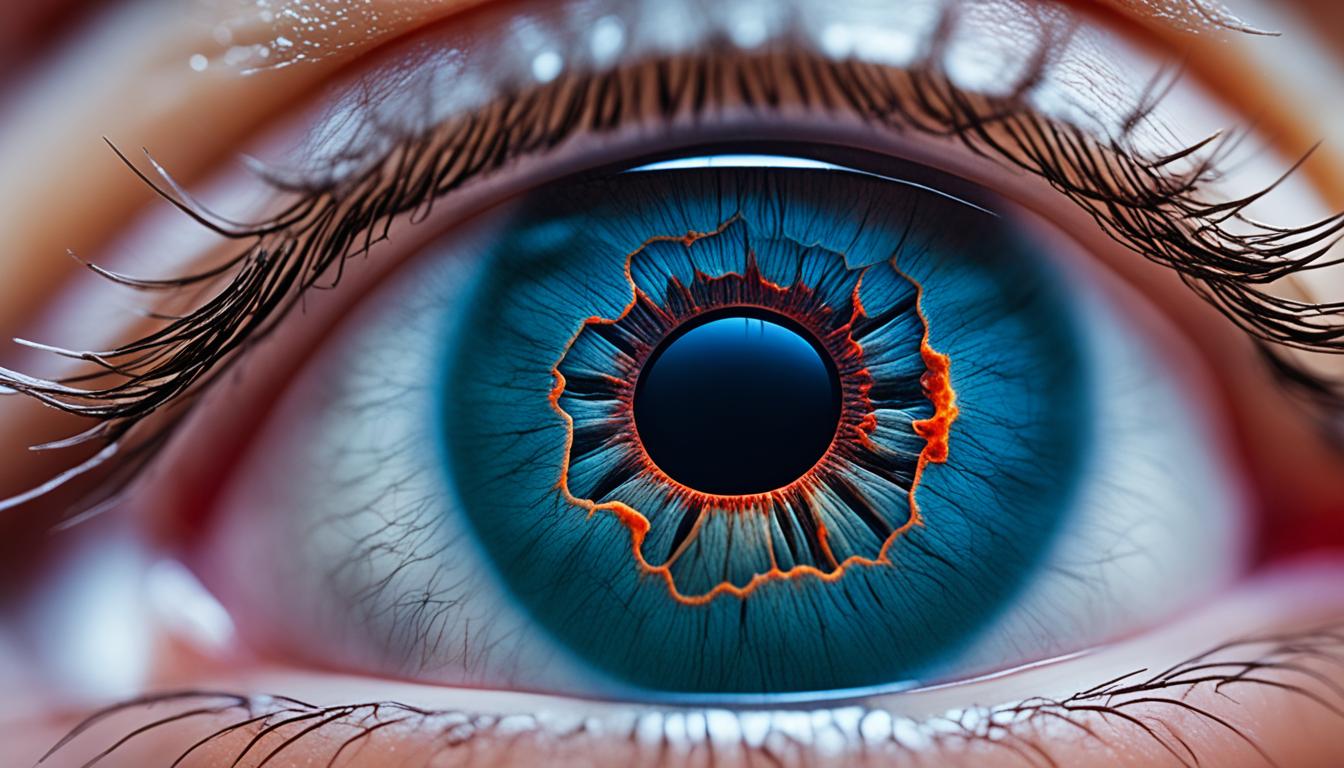Retinoblastoma is a rare eye cancer found in children under three. It grows in the back of the eye. The first sign is a white spot in their eye, often seen in photos. This light reflection shows a tumor is there. Kids with this cancer might have eyes that don’t look the same way or seem red and hurt. The type of cancer they have can sometimes affect both eyes and might run in the family.
Knowing if retinoblastoma is hereditary matters a lot. It helps doctors decide on the best care early on. Quick treatment gives kids better chances of doing well. Doctors are also looking into using stem cell therapy to fight this cancer.
Key Takeaways:
- Cancer retinoblastoma primarily affects children under the age of three.
- Leukocoria, the “white pupil,” is the main symptom of retinoblastoma.
- Symptoms may also include misalignment of the eyes, red or inflamed eyes, and glaucoma.
- Genetic testing helps determine the heritability of retinoblastoma.
- Early diagnosis is crucial for less intense treatment and better outcomes.
Retinoblastoma Diagnosis and Testing
Getting the right diagnosis quickly is key in fighting retinoblastoma. It’s a rare but serious eye cancer in kids. Doctors use many tests to spot and understand retinoblastoma. This helps plan the best treatment for each child.
Eye exams are vital for finding retinoblastoma. Through ophthalmoscopy, doctors check your eye’s back to find any tumors or issues. They may also do fluorescein angiography to see more about your eye’s blood vessels and check on tumor growth.
If retinoblastoma might run in your family, you might do genetic testing. This test looks at the RB1 gene, linked with the disease. It tells doctors if it’s likely to pass on and helps plan treatment.
Ultrasounds and MRI (magnetic resonance imaging) can also be used. They give clear pictures of the tumors. This helps know how big they are and if they’ve spread to other parts of the eye.
The International Retinoblastoma Staging System (IRSS) tells us the cancer’s stage. It looks at tumor size, how many there are, and if they’ve spread. Knowing the stage is key for choosing the right treatment and understanding what to expect.
| Diagnostic Methods | Advantages |
|---|---|
| Eye exams (ophthalmoscopy and fluorescein angiography) | Provide direct visualization of the retina and tumors |
| Genetic testing (RB1 gene testing) | Identify heritable or non-heritable form of retinoblastoma |
| Ultrasound exams and MRI | Evaluate tumor size and extent |
Retinoblastoma Treatment Options
Treatment for retinoblastoma varies based on the disease stage and how far the tumor has spread. Retinoblastoma treatment tries to remove the tumor while keeping as much vision as possible. The plan can mix different therapies for each person’s case.
Surgery
Retinoblastoma surgery is key in treating this eye cancer. Doctors might use laser treatment or freeze the tumor if it’s small. In severe cases, the whole eye must be removed to stop the cancer from spreading and improve survival odds.
Chemotherapy and Radiation Therapy
Chemotherapy often fights retinoblastoma. It uses strong drugs to kill cancer cells. This treatment can be pills, through a vein, or into the eye. It’s helpful before or after surgery and can stop tumors from coming back.
Radiation therapy can join chemo or be used alone. It zaps cancer cells with strong energy. Doctors are careful to target only the tumor to keep healthy tissue safe.
Other Treatment Approaches
For some, intra-arterial chemotherapy is the way to go. It sends chemo straight into the artery feeding the tumor. This method makes sure the cancer gets a strong dose of the drug.
New treatments like proton therapy and immunotherapy are also under study. Proton therapy uses a specific kind of beam to hit cancer cells accurately. Immunotherapy uses the body’s defenses to fight off the cancer.
It’s vital for patients and families to talk about treatment choices with their healthcare team. This helps in making the best decision for the specific situation.
| Treatment | Description |
|---|---|
| Surgery | Focal therapy, such as laser photocoagulation or cryotherapy, to destroy small tumors. Enucleation for advanced cases. |
| Chemotherapy | Systemic treatment using drugs to target and kill cancer cells, administered orally, intravenously, or directly into the eye. |
| Radiation Therapy | Utilizes high-energy beams to target and destroy cancer cells. Minimizes damage to healthy tissues around the tumor. |
| Intra-arterial Chemotherapy | Targeted delivery of chemotherapy directly into the artery supplying blood to the tumor for enhanced effectiveness. |
| Proton Therapy | Uses proton beams to precisely target and destroy cancer cells while minimizing damage to healthy tissues. |
| Immunotherapy | Harnesses the body’s immune system to recognize and destroy cancer cells. |
Conclusion
Retinoblastoma is a rare cancer that mainly affects children. It’s hard to spot early and treat. But, quick action is key to a better prognosis and saving eyesight. Using advanced genetic tests helps doctors figure out if the disease runs in families. This knowledge guides treatment choices.
There is hope in the fight against retinoblastoma. New treatments, such as stem cell therapy, are being developed. Experts are learning more about the disease every day. They’re looking for new ways to treat it based on each patient’s needs.
Worldwide, doctors and researchers are teaming up to tackle retinoblastoma. Their work aims to improve how we treat and understand the disease. By sharing their findings, they hope to give children with retinoblastoma a brighter future. Together, they are striving for better health and a good quality of life for these young patients.

